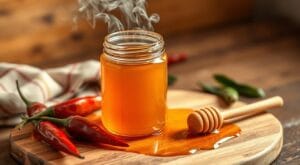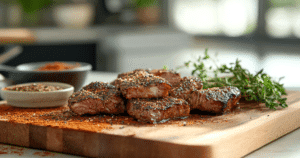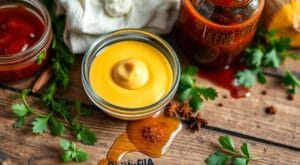Jump to:
Estimated reading time: 14 minutes
Table of contents
Introduction
Meatloaf is a beloved comfort food that has been enjoyed in kitchens worldwide for generations. Its simple yet satisfying nature makes it a top choice for family dinners, potlucks, and casual gatherings. However, perfecting meatloaf can be challenging, particularly when it comes to cooking it at the right temperature. Finding the ideal cooking temperature is crucial to ensure that the meatloaf is evenly cooked, remains juicy, and has a delicious crust.
In this guide, we will delve into the best meatloaf cooking temperature, the science behind it, tips for achieving perfect texture, and common mistakes to avoid. Whether you’re a seasoned cook or new to making meatloaf, this article will equip you with the knowledge you need to ensure your meatloaf turns out perfectly every time.
Understanding Meatloaf Cooking Temperatures
The Importance of a Good Meatloaf Cooking Temperature
Cooking meatloaf at the right temperature is essential for several reasons. Firstly, it ensures the meatloaf is cooked safely. Ground meat, the main ingredient in meatloaf, must reach a specific internal temperature to be safe to eat. Secondly, cooking at the right temperature helps achieve the desired texture—juicy on the inside with a slight crust on the outside. Lastly, cooking at the correct temperature allows the flavors to meld, resulting in a well-balanced, flavorful dish.
The Ideal Internal Temperature for Meatloaf
The ideal internal temperature for meatloaf is 160°F (71°C). This temperature ensures that the ground meat is fully cooked, eliminating any harmful bacteria. The USDA recommends this internal temperature for all ground meats, including beef, pork, and poultry. Cooking meatloaf to 160°F ensures that it is both safe to eat and remains juicy.
To accurately measure the internal temperature of your meatloaf, use a reliable meat thermometer. Insert the thermometer into the thickest part of the meatloaf, ensuring it is not touching the sides of the pan or any fillings. Once the thermometer reads 160°F, your meatloaf has reached the right cooking temperature and can be removed from the oven.
Choosing the Best Oven Temperature for Meatloaf
While the internal temperature is crucial, the oven temperature at which you cook your meatloaf is equally important. The most common oven temperature for cooking meatloaf is 350°F (175°C). This moderate temperature allows the meatloaf to cook evenly without drying out. Cooking at 350°F ensures that the outside of the meatloaf develops a slight crust while the inside remains tender and juicy.
For those who prefer a quicker cooking time, some recipes suggest cooking meatloaf at 375°F (190°C). This higher temperature can reduce cooking time but also increases the risk of the meatloaf drying out if left in the oven too long. If you choose to cook your meatloaf at 375°F, monitor the internal temperature closely to avoid overcooking.
Conversely, cooking meatloaf at a lower temperature, such as 300°F (150°C), results in a longer cooking time but can yield a very tender meatloaf. This lower temperature allows the meat to cook more slowly, which helps retain moisture. However, the downside is that the meatloaf may not develop as much of a crust on the outside. It’s important to decide based on your preference while still achieving the right meatloaf cooking temperature.
The Science Behind a Good Meatloaf Cooking Temperature
Protein Coagulation and Moisture Retention
When cooking meatloaf, the goal is to achieve the perfect balance between protein coagulation and moisture retention. Protein coagulation occurs when the proteins in the meat are exposed to heat, causing them to tighten and solidify. This process gives meatloaf its firm structure. However, if the proteins coagulate too quickly or too much, the meatloaf can become tough and dry. Cooking at the right temperature ensures this balance is maintained.
At the same time, moisture retention is critical for keeping the meatloaf juicy. Ground meat contains a significant amount of water, which can evaporate during cooking. Cooking at the right temperature ensures that the proteins coagulate just enough to hold the meatloaf together while retaining enough moisture to keep it tender.
The Maillard Reaction and Flavor Development
The Maillard reaction is a chemical reaction between amino acids and reducing sugars that occurs when meat is exposed to heat. This reaction is responsible for the browning of the meatloaf’s surface and contributes to the development of complex, savory flavors. Cooking meatloaf at the right temperature allows the Maillard reaction to occur, resulting in a flavorful crust that complements the tender interior.
For the Maillard reaction to occur effectively, the surface of the meatloaf needs to reach a temperature of around 300°F (150°C). This is why cooking meatloaf at 350°F (175°C) is often considered ideal—it allows the outside to brown while the inside cooks through. However, if the oven temperature is too high, the outside may brown too quickly, leading to a burnt crust and an undercooked interior.
Tips for Achieving the Perfect Meatloaf Cooking Temperature
Choosing the Right Meat
The type of ground meat you use in your meatloaf can significantly affect the cooking temperature and time. Ground beef with a higher fat content, such as 80/20 (80% lean, 20% fat), is ideal for meatloaf because it provides enough fat to keep the meatloaf moist during cooking. Leaner meats, such as ground turkey or chicken, may require extra moisture, such as added broth or vegetables, to prevent them from drying out when cooked at the right temperature.
When using a mixture of meats, such as ground beef and pork, consider the fat content of each meat. A good balance of fat and lean meat will help ensure the meatloaf stays moist while also holding its shape when cooked at the right temperature.
Mixing the Ingredients
How you mix the ingredients for your meatloaf impacts its final texture. Overmixing the meat can cause it to become dense and tough, while undermixing can result in a loose, crumbly loaf. To avoid these issues, gently mix the ingredients just until they are combined. Using your hands to mix the meatloaf allows you to feel when the mixture is evenly distributed without overworking it, which is crucial when cooking at the right temperature.
Shaping the Meatloaf for Even Cooking
The shape of your meatloaf can affect how it cooks. A loaf that is too thick may take longer to cook through, while a loaf that is too thin may dry out quickly. Aim for a loaf that is about 2 to 3 inches thick, which will allow for even cooking. Additionally, shaping the meatloaf with slightly rounded edges rather than sharp corners can help prevent the edges from burning.
Adding a Glaze
A glaze not only adds flavor to your meatloaf but also helps it develop a nice crust. Classic glazes often include ingredients like ketchup, brown sugar, and mustard, but you can get creative with BBQ sauce, teriyaki sauce, or even a balsamic reduction. Apply the glaze about 20 minutes before the meatloaf is done cooking to allow it to caramelize without burning.
Checking the Internal Temperature
As mentioned earlier, checking the internal temperature of your meatloaf is the most reliable way to ensure it is fully cooked. Insert the thermometer into the thickest part of the loaf, making sure it is not touching the pan. Once the temperature reaches 160°F (71°C), the meatloaf is done.
If you’re cooking meatloaf with a filling, such as cheese or vegetables, be sure to check the temperature in multiple spots to ensure the entire loaf is cooked through.
Letting the Meatloaf Rest
After removing the meatloaf from the oven, let it rest for about 10-15 minutes before slicing. Resting allows the juices to redistribute throughout the meat, resulting in a juicier, more flavorful meatloaf. Cutting into the meatloaf too soon can cause the juices to run out, leaving the meatloaf dry.

Common Mistakes to Avoid When Cooking at the Good Meatloaf Cooking Temp
Cooking at Too High a Temperature
One of the most common mistakes when cooking meatloaf is setting the oven temperature too high. While a higher temperature can reduce cooking time, it also increases the risk of drying out the meatloaf or burning the outside before the inside is fully cooked. Stick to the good cooking temp of 350°F (175°C) for the best results.
Not Using a Meat Thermometer to Check for the Good Cooking Temp
Relying solely on cooking time or visual cues can lead to undercooked or overcooked meatloaf. A meat thermometer is an essential tool for checking the internal temperature and ensuring the meatloaf is cooked to perfection at the good meatloaf cooking temp. If you don’t have a meat thermometer, consider investing in one—it will make a big difference in the quality of your meatloaf.
Overmixing the Meatloaf Mixture at the Good Cooking Temp
As mentioned earlier, overmixing the meatloaf mixture can result in a dense, tough loaf. To avoid this, mix the ingredients gently and stop as soon as everything is evenly combined. If the mixture feels too sticky, you can add a little more breadcrumbs or oats to help absorb the moisture, especially when cooking at the good meatloaf cooking temp.
Skipping the Resting Period After Cooking at the Good Cooking Temp
Skipping the resting period is another common mistake that can lead to a dry meatloaf. Resting allows the juices to settle, making the meatloaf easier to slice and more enjoyable to eat. Be patient and give the meatloaf time to rest before serving to get the full benefits of cooking at the good meatloaf cooking temp.
Not Adjusting for Different Types of Meat When Cooking at the Good Meatloaf Cooking Temp
Different types of meat have different fat contents and cooking requirements. For example, ground turkey or chicken is leaner than ground beef and may require additional moisture to prevent drying out, especially when cooked at the good meatloaf cooking temp. If you’re using a leaner meat, consider adding extra liquid, such as broth, or incorporating moisture-rich ingredients like grated vegetables.
Creative Variations and Cooking Methods for Achieving the Good Meatloaf Cooking Temp
Slow Cooker Meatloaf
If you prefer a hands-off approach, cooking meatloaf in a slow cooker is a great option. Slow cooking allows the meatloaf to cook evenly and stay moist throughout the process. To cook meatloaf in a slow cooker, shape the meatloaf and place it in the slow cooker. Cook on low for 6-8 hours or on high for 3-4 hours, until the internal temperature reaches 160°F (71°C). This method is ideal for maintaining the good meatloaf cooking temp throughout the process.
Smoked Meatloaf
For those who enjoy smoky flavors, smoking meatloaf is a delicious alternative to baking. To smoke meatloaf, set your smoker to 225°F (107°C) and place the meatloaf on the smoker rack. Smoke for 2-3 hours, or until the internal temperature reaches 160°F (71°C). The slow cooking and smoke infusion will result in a tender, flavorful meatloaf with a rich, smoky taste, and it will still achieve the good meatloaf cooking temp.
Grilled Meatloaf
Grilling meatloaf adds a unique flavor and texture to the dish. To grill meatloaf, preheat your grill to medium heat (about 350°F/175°C) and place the meatloaf on a grill-safe baking sheet or directly on the grill grates if you’re confident it won’t fall apart. Cook for 40-60 minutes, turning occasionally and basting with your favorite sauce, until the internal temperature reaches 160°F (71°C), ensuring it hits the good meatloaf cooking temp.
Mini Meatloaves
Mini meatloaves are a fun and convenient way to enjoy this classic dish. They cook faster than a full-sized loaf and are perfect for individual servings. To make mini meatloaves, divide the meatloaf mixture into muffin tins or shape them into small loaves on a baking sheet. Bake at 350°F (175°C) for 20-30 minutes, or until the internal temperature reaches 160°F (71°C). This method ensures each mini meatloaf reaches the good meatloaf cooking temp quickly and evenly.
Vegetarian and Vegan Meatloaf
For those following a vegetarian or vegan diet, there are plenty of plant-based alternatives to traditional meatloaf. Lentils, chickpeas, and mushrooms are popular base ingredients for vegetarian meatloaf, providing a hearty texture and rich flavor. When making a vegetarian or vegan meatloaf, be sure to use plant-based binders, such as flaxseed meal or chia seeds, and adjust the cooking temperature and time as needed to ensure it holds together and reaches the good meatloaf cooking temp.
Serving Suggestions and Side Dishes for Meatloaf Cooked at the Good Meatloaf Cooking Temp
Classic Side Dishes for Meatloaf Cooked at the Good Meatloaf Cooking Temp
Meatloaf pairs well with a variety of classic side dishes, making it a versatile option for any meal. Some popular sides include:
- Mashed Potatoes: Creamy mashed potatoes are the perfect complement to meatloaf, providing a smooth, buttery contrast to the savory meat cooked at the good meatloaf cooking temp.
- Roasted Vegetables: A mix of roasted carrots, Brussels sprouts, and sweet potatoes adds color and flavor to your plate.
- Green Beans Almondine: Lightly sautéed green beans with toasted almonds add a fresh, crunchy element to your meal.
- Cornbread: Sweet, buttery cornbread is a Southern favorite that pairs beautifully with the rich flavors of meatloaf.
Creative Sauces and Glazes for Meatloaf Cooked at the Good Meatloaf Cooking Temp
While classic ketchup-based glazes are always a hit, there are plenty of creative ways to add flavor to your meatloaf:
- BBQ Sauce: A smoky BBQ sauce adds depth and richness to the meatloaf cooked at the good meatloaf cooking temp.
- Teriyaki Glaze: For an Asian-inspired twist, try a teriyaki glaze with soy sauce, ginger, and honey.
- Balsamic Reduction: A tangy balsamic reduction adds a touch of elegance to your meatloaf, balancing the savory flavors with a hint of sweetness.
Storing and Reheating Leftovers for Meatloaf Cooked at the Good Meatloaf Cooking Temp
If you have leftover meatloaf, it can be easily stored and reheated for later enjoyment:
- Refrigeration: Store leftover meatloaf in an airtight container in the refrigerator for up to 4 days.
- Freezing: To freeze meatloaf, wrap it tightly in plastic wrap and place it in a freezer-safe container. Frozen meatloaf can be stored for up to 3 months. Thaw in the refrigerator overnight before reheating.
- Reheating: To reheat meatloaf, place it in a baking dish and cover it with foil. Heat in the oven at 325°F (163°C) for 15-20 minutes, or until warmed through. You can also reheat individual slices in the microwave, though the texture may be slightly different after being cooked at the good meatloaf cooking temp.
Frequently Asked Questions
What temperature should I cook meatloaf at?
The ideal oven temperature for cooking meatloaf is 350°F (175°C). This moderate temperature allows the meatloaf to cook evenly without drying out, giving it a juicy, tender texture with a nicely browned crust.
How long should I cook meatloaf at 350°F?
At 350°F, a standard 2-pound meatloaf will typically take about 1 to 1.5 hours to reach the recommended internal temperature. Cooking times may vary based on the size and thickness of the meatloaf, so using a meat thermometer is the best way to ensure it’s done.
What internal temperature should meatloaf reach to be safe?
The USDA recommends cooking ground meat to an internal temperature of 160°F (71°C) to ensure safety. Insert a meat thermometer into the center of the meatloaf to confirm it has reached this temperature before removing it from the oven.
Conclusion
When cooking meatloaf, it’s essential to achieve the right internal temperature to ensure it’s both safe to eat and delicious. For a traditional meatloaf, the internal temperature should reach 160°F for ground beef or 165°F if you’re using poultry. To explore how different cooking methods, such as using a pellet grill, can impact the final outcome, check out this guide on Temperature Pellet Grill Meatloaf. For those who enjoy a smoky flavor, the article on Smoked Meatloaf: A Flavorful Twist on a Classic Comfort Food provides tips on maintaining the right temperature during the smoking process. Additionally, understanding the role of ingredients in reaching and maintaining the right temperature is crucial, as discussed in the articles Why Use Milk Instead of Water in Meatloaf: A Deep Dive into the Ingredients and Meatloaf Stability: Key Ingredients.
Consider using a meat thermometer as explained in this guide on Temperature at Which Meatloaf is Done. For those interested in variations, such as turkey or keto meatloaf, you can explore detailed recipes and temperature tips at Turkey Meatloaf Recipes and Keto Meatloaf Recipes. These resources will help you achieve the perfect meatloaf every time, whether you prefer classic, turkey, or keto versions.
With these insights, you’re well on your way to making meatloaf that your family and friends will love, whether it’s served with classic sides or enjoyed in creative new ways. Happy cooking!






